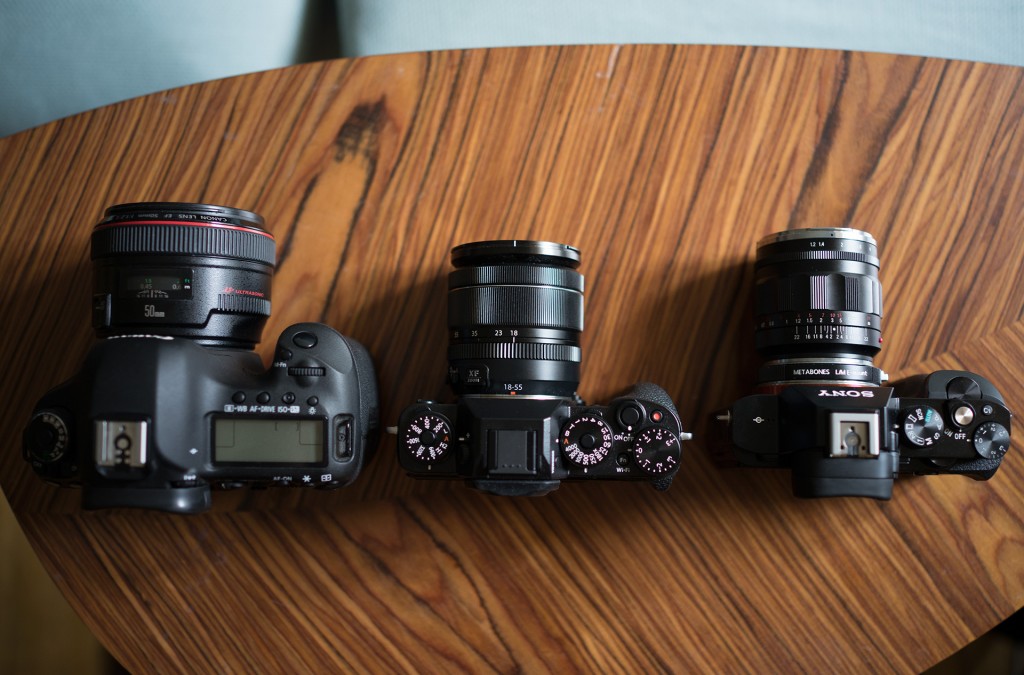I’ve had the A7S for over a week now and can share my initial thoughts, even some firm conclusions. Here’s one I’ve come to already – the Sony A7S is the best consumer camera Sony have ever made.
For $2500 the video performance of the A7S sits between the FS700 ($8000) and F5 ($17,000) yet the full frame sensor lends more character and allows for groundbreaking low light performance.
However there’s one thing missing from the A7S that I’d really love to see in a firmware update – the ability to load your own LUT for S-LOG 2 onto the SD card.
It is really tricky to get your exposure right when shooting S-LOG 2 on the camera display. The Atomos Shogun will have support for LUTs so that is yet another reason to get the 4K recorder when it is released this coming September.
There’s another caveat that isn’t really the fault of the camera at all. S-LOG 2 requires serious grading knowledge to get the best out of. If you have never used this before…
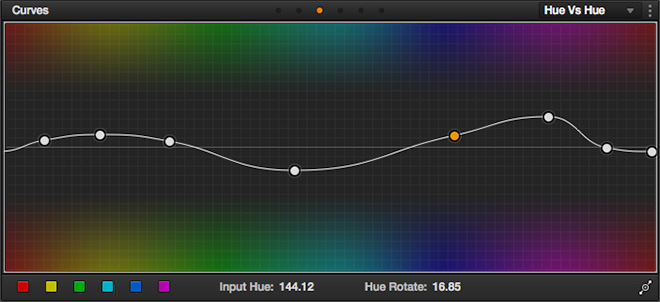
Then unfortunately it is time to learn how!
Sony have put professional video features on the A7S and S-LOG 2 is one of them. The more general consumer that will buy this camera simply will not be able to get the best out of the image.
The consumer Sony picture profiles for JPEGs just do not give you the same workflow or image quality, so you are compelled to learn to grade or at least apply the LUTs and looks created by others (such as my own here). Even raw on Blackmagic cameras is more friendly than S-LOG because you can just open the raw files on default settings. With S-LOG you have to grade, you have no choice. You have to learn how to use LUTs, how to export them from Resolve to Premiere, how to manipulate the luma curve, the RGB curves, the lot. It is a steep learning curve. L-Curve!
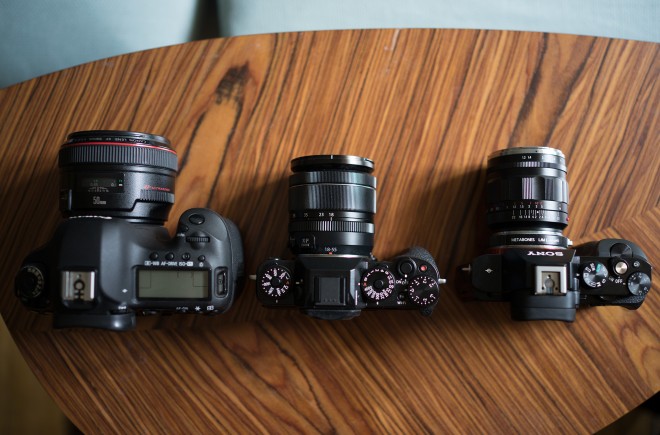
Above: from left to right – 5D Mark III with Canon 50mm F1.2L, Fuji X-T1 and Sony A7S with Voigtlander 35mm F1.2 Aspherical
The best sensor I have ever shot on
Digital cameras have usually been sold on the basis of megapixels per dollar. Here with the A7S it is the quality of the pixel not the quantity, that matters. After covering the mainstream bases with the A7 (low price) and A7R (high megapixels for the price) Sony now targets that smaller niche of people who actually just want a good image – and know what one is.
The higher price of the A7S is justified on so many levels. Firstly that 12MP count is a big marketing risk. Secondly the yields from a silicon wafer with such a larger sensor are far lower than for APS-C.
Additionally the yield of megapixels per dollar is much lower compared to the A7 or A7R so the A7S has to be sold to a more educated consumer willing to look beyond the ‘headline number’. The end result is brave, compelling and unique. Sony are alone in having the guts to do a 12MP consumer camera in 2014 albeit one with pro leanings.
ISO 12,800 on this camera looks like ISO 800 on the GH4. ISO 3200 looks like ISO 200 on the 5D Mark III. Dynamic range is 14 stops in raw stills – close to it in S-LOG. The overall image is spectacular.
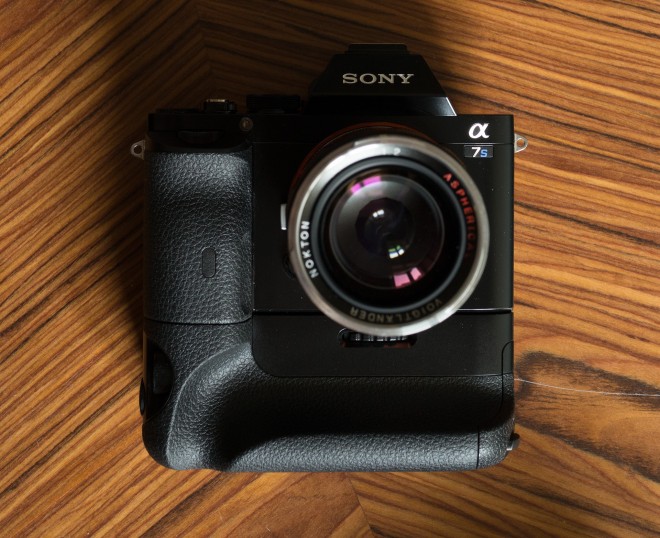
Codec
In the A7S one of the world’s best full frame sensors is finally backed up by a professional standard video processor and codec.
Having seen mediocre performance from XAVC-S on the AX100 and RX100 III, my expectations were that this would be the Achilles heel of the A7S but it is actually one of the camera’s greatest strengths. The encoder in the A7S is far better and actually I’d rank it higher than Sony’s pro camera the FS700. It is incredibly efficient and grades on par with ProRes recorded via HDMI.
It only has one flaw and that is on fast unpredictable motion blur you get a lot of macro-blocking, so a recorder like the tiny Atomos Ninja Star will be useful there.
SLOG 2 which was a $3800 upgrade just a few years ago on the Sony CineAlta F3 really does work on this camera to deliver enormous dynamic range without the usual artefacts and banding we’ve seen with flat picture profiles before on DSLRs. The image once graded is silky smooth at the native ISO of 3200. What grain there is left helps to dither the 8bit bands together more smoothly. Yes there is some more ugly noise in the very deepest darkest areas of the S-LOG image but this should not appear in your final image unless you’ve made a mistake either with exposure or with your grade.
The 5D Mark III in raw files cannot achieve the same dynamic range as S-LOG on the A7S while still maintaining low noise in shadow areas lifted in post.
Like the GH4 the A7S has a full pixel readout which means much crisper detail and less banding in skies and areas of plain colour. Resolution in 1080p is extremely good internally, yet 4K to the Shogun in September is an absolutely mouthwatering prospect.
Less rolling shutter skew is a button press away
In full frame recording mode at 24p rolling shutter is of course more severe than on the more expensive professional Super 35mm cinema cameras. It is easy to over-blow the problem though because in practical every day shooting rolling shutter is sometimes a problem, sometimes not. It depends on the kind of shoot and shooting style. Those who do fast handheld camera movements, whip pans or shoot handheld at the long end of a telephoto lens will want to enable the reduced rolling shutter skew mode of the A7S of which there are two.
Super 35mm mode (APS-C mode as the A7S calls it) gives you roughly equal rolling shutter skew to the FS100. That’s incredibly impressive given that the A7S is reading out 4x the resolution from the sensor.
Switching to 60p in Super 35mm mode further reduces skew. The results are impressively detailed and you get a clean image with no increase in moire or aliasing.
APS-C mode also works over the 4K HDMI output. How is this possible? The camera appears to crop the 12MP full frame sensor to approximately 2768 x 1560 and upscales this 2.8K image to 4K with only minimally less detail than in true full frame 4K mode. You can add a Metabones Speed Booster if you need the look to match your 24p shots in full frame mode. If you enable 60p in full frame mode the sensor starts pixel binning and you get moire and softness so always shoot at 24,25 or 30p in full frame mode.
Image quality
The A7S resolves slightly more detail in 1080p than the 5D Mark III can manage even in raw 1080p – and of course compared to the stock H.264 video on the Canon it’s a non contest as you can see from the shootout video.
As I noted in the shootout video, the A7S scratches a very large itch. I haven’t felt this satisfied with a camera since the GH2 came out.
I liked 4K on the GH4 and still do, it’s a fantastic camera and cheaper than the A7S, doing 4K internally with much smaller file sizes than 4K externally to ProRes will clock in with. Dynamic range on the GH4 is also pretty impressive given the much smaller sensor and higher megapixel count.
However the A7S is full frame. There’s no getting away from that. Even versus the 1.5x crop of Super 35mm over full frame, the feel of your images,especially at the 24-50mm range of your lens is completely different. Good though Speed Booster is, the GH4 cannot quite mimic it with one, not without softer edges and corners if you push beyond a 0.71x focal reducer to something like 0.58x.
The Sony A7S is timely because I need a replacement for my ageing 5D Mark III despite the fact I love the image with Magic Lantern Raw video, the file sizes mount up over the months and become a real headache, deleting the raw masters a folly. I’ve also found reliability for continuous recording to be an issue at times, probably due to file fragmentation on my cards. So I am over the moon that the XAVC-S codec in the A7S with S-LOG is able to give me an equivalent image which grades fantastically for my needs yet with small file sizes.
In short all I wanted was the image quality of 14bit raw from a full frame sensor in small compressed files, the mirrorless form factor of the GH4 and the option for 4K when required later….Not too much to ask surely!? 🙂
Well Sony have delivered it!
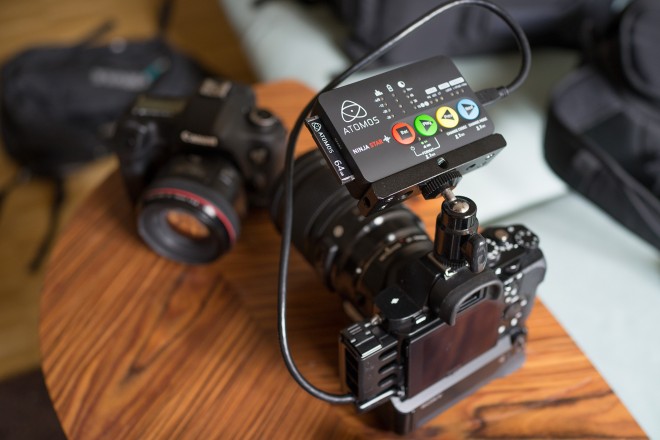
Cleaner and quieter for stills compared to A7R
For some uses the 36MP resolution of the A7R is going to still be useful for photographers, but I am not one of those people. For me the sensitivity of the A7S is far more creatively important.
The difference in number may seem large between 12 megapixels and 36 but the difference in reality feels far less when you view or print the images.
Additionally the silent electronic-shutter mode of the A7S like the GH4 is just lovely….it makes the camera far sleeker and stealthier to use, overall more pleasing and more mannered in public spaces.
The A7R clanks away, the shutter feels like a diesel engine in a Tesla Model S. Electricity is the FUTURE! Someone tell Canon and Nikon!
The continuous shooting rate of the A7S in e-shutter mode is significantly quicker than on the A7R. The images have the same wide dynamic range and colour gamut I am accustomed to from the excellent 36MP Sony sensor in the Nikon D800 and A7R so there’s no compromise there.
Also the camera feels more responsive overall, due to a faster processor. It seems snappier in the menus and quicker to start up.
Areas of improvement and caveats!
A lot of the quirks here are forgivable but some of them are a little bit silly.
Mainly they are ergonomic quirks like not being able to assign APS-C or silent shutter mode to a custom button, or even the function menu for quicker access.
The batteries are rather on the small side, certainly compared to the GH4. Because of the massive sensor and very fast processor the A7S runs down the juice quicker than the GH4. You really need the A7 battery grip for this one. The grip works well ergonomically apart from one glaring fault – the shutter release button is too easy to put pressure on as you hold it for horizontal video shooting. There doesn’t seem to be a way to disable or lock it. The button should really be on a sloped part but it is flush to the flat surface and right against your hand.
The video record button is really awkwardly placed, but bafflingly cannot be assigned to the C1 button next to the shutter release or the shutter button itself in video mode.
In video mode you can’t take stills and in movie mode you can’t get the full quality magnified focus zoom and peaking is less effective where it is most needed.
If you try shooting video in stills mode and silent mode is enabled, you can’t select S-LOG or the other pro video picture profiles unless you enable the mechanical shutter, which is deeply odd 🙂
It is a shame the EVF is not up to the benchmark set by the Fuji X-T1 considering Sony led the way here with the A7R but I am sure on a Mark II update this will be an area of further improvement. To be honest it isn’t exactly that bad as it is, just not the best any more.
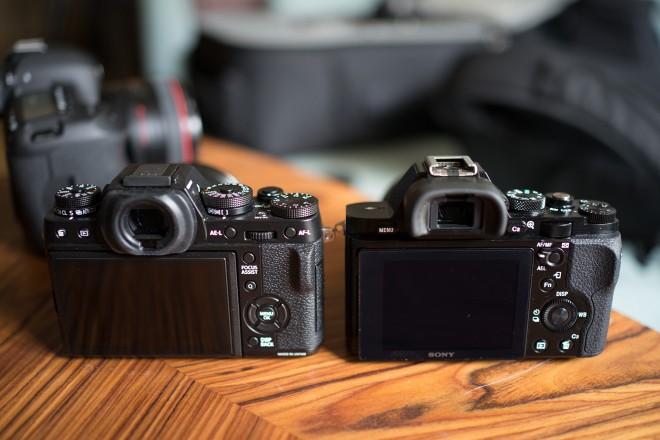
The US model is NTSC locked and the European & Hong Kong version is PAL / NTSC switchable. However when set to NTSC you get a persistent Running on NTSC message to dismiss on every boot-up which is a bit unnecessary.
There’s some more minor quirks which I have sent to Sony, who appear to be doing an excellent job listening to users.
Evolving review continues…
The Sony A7S is the first camera to really beat the Canon 5D Mark III on pretty much every level for both stills and video, especially the latter. The A7R did not have the video quality to topple Canon. The A7S not only topples Canon, it destroys their claim to video quality on DSLRs. Canon’s dated consumer and semi-pro DSLRs are now in serious disarray for video and in some ways stills too (dynamic range and low light for instance). In terms of the video shooter they risk losing the market which gave birth to their pro line of Cinema EOS cameras altogether. I warned them about this 3 years ago and nothing has been done. They have focussed all their efforts on Cinema EOS and completely neglected the lower end video shooter.
I can think of absolutely zero reason to shoot on stock Canon 5D Mark III video settings when you can shoot XAVC-S on the A7S.
As for raw, it’s becoming a little harder to justify the larger files now the gain in image quality and grading ability has narrowed to the best compressed codecs. S-LOG is fantastic. If you’re competent at grading LOG footage (quite a complex acquired skill that takes time to master) then S-LOG 2 on the A7S will give you an image in the ballpark of raw with Magic Lantern on the 5D Mark III but with XAVC-S file sizes which are 300 MB per minute compared to 6GB per minute of uncompressed raw. These images also have far less noise and are delivered from a form factor more suited to shooting video.
Those without the necessary grading expertise can wait for Film Convert to support S-LOG for the A7S. It already supports S-LOG on the FS700.
For Blackmagic and Panasonic GH4 users it is a tougher choice and it will definitely come down to individual taste, lenses, needs and projects. Further on in the review I’ll try and delve deeper into that and allow you to make your own mind up about which way to go. For instance the GH4 and Blackmagic cameras still have unique features not offered on the A7S, like global shutter and internal 4K recording.
I’ll keep adding parts to this review. There’s just too much to cover in one session!



